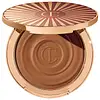What's inside
What's inside
 Key Ingredients
Key Ingredients

 Benefits
Benefits

 Concerns
Concerns

 Ingredients Side-by-side
Ingredients Side-by-side

Ethylhexyl Palmitate
EmollientTitanium Dioxide
Cosmetic ColorantCaprylyl Methicone
Skin ConditioningC10-18 Triglycerides
EmollientMethyl Methacrylate Crosspolymer
Mica
Cosmetic ColorantPolysilicone-11
Silica
AbrasiveCera Microcristallina
Emulsion StabilisingSynthetic Wax
AbrasiveCyclopentasiloxane
EmollientAlumina
AbrasivePentaerythrityl Tetrabehenate
EmollientCaprylic/Capric Triglyceride
MaskingTridecyl Trimellitate
EmollientButyloctyl Salicylate
Skin ConditioningLauryl PEG-10 Tris(Trimethylsiloxy)Silylethyl Dimethicone
EmulsifyingParaffin
PerfumingPolymethylsilsesquioxane
Tristearin
Skin ConditioningPhenoxyethanol
PreservativeAluminum Hydroxide
EmollientTriisostearyl Citrate
EmollientMagnesium Myristate
Triethoxycaprylylsilane
Ethylhexylglycerin
Skin ConditioningLaureth-12
EmulsifyingJojoba Esters
EmollientOctyldodecanol
EmollientHelianthus Annuus Seed Wax
Skin ConditioningEchium Plantagineum Seed Oil
Skin ConditioningAcacia Decurrens Flower Wax
EmollientPolyglycerin-3
HumectantHelianthus Annuus Seed Oil Unsaponifiables
EmollientCardiospermum Halicacabum Flower/Leaf/Vine Extract
Skin ConditioningTocopherol
AntioxidantIron Oxides
Ethylhexyl Palmitate, Titanium Dioxide, Caprylyl Methicone, C10-18 Triglycerides, Methyl Methacrylate Crosspolymer, Mica, Polysilicone-11, Silica, Cera Microcristallina, Synthetic Wax, Cyclopentasiloxane, Alumina, Pentaerythrityl Tetrabehenate, Caprylic/Capric Triglyceride, Tridecyl Trimellitate, Butyloctyl Salicylate, Lauryl PEG-10 Tris(Trimethylsiloxy)Silylethyl Dimethicone, Paraffin, Polymethylsilsesquioxane, Tristearin, Phenoxyethanol, Aluminum Hydroxide, Triisostearyl Citrate, Magnesium Myristate, Triethoxycaprylylsilane, Ethylhexylglycerin, Laureth-12, Jojoba Esters, Octyldodecanol, Helianthus Annuus Seed Wax, Echium Plantagineum Seed Oil, Acacia Decurrens Flower Wax, Polyglycerin-3, Helianthus Annuus Seed Oil Unsaponifiables, Cardiospermum Halicacabum Flower/Leaf/Vine Extract, Tocopherol, Iron Oxides
Dimethicone
EmollientTriethylhexanoin
MaskingCeresin
Emulsion StabilisingPolymethylsilsesquioxane
Dimethicone Crosspolymer
Emulsion StabilisingTrimethylsiloxysilicate
EmollientPolyethylene
AbrasiveDimethicone/Polyglycerin-3 Crosspolymer
CleansingSilica
AbrasiveMica
Cosmetic Colorant7-Dehydrocholesterol
Emulsion StabilisingC10-18 Triglycerides
EmollientSodium Hyaluronate
HumectantTriolein
Skin ConditioningGlyceryl Dioleate
EmollientDipropylene Glycol
HumectantSodium Citrate
BufferingTocopherol
AntioxidantCI 77891
Cosmetic ColorantIron Oxides
Dimethicone, Triethylhexanoin, Ceresin, Polymethylsilsesquioxane, Dimethicone Crosspolymer, Trimethylsiloxysilicate, Polyethylene, Dimethicone/Polyglycerin-3 Crosspolymer, Silica, Mica, 7-Dehydrocholesterol, C10-18 Triglycerides, Sodium Hyaluronate, Triolein, Glyceryl Dioleate, Dipropylene Glycol, Sodium Citrate, Tocopherol, CI 77891, Iron Oxides
Ingredients Explained
These ingredients are found in both products.
Ingredients higher up in an ingredient list are typically present in a larger amount.
C10-18 Triglycerides is a skin conditioning and texture-enhancer.
It is created from glycerin and a mixture of C10-18 fatty acids.
This ingredient improves spreadability and helps thicken a product.
According to manufacturers, it usually comes from vegetable-based saturated fatty acids. Common bases for this ingredient are coconut oil, palm kernel oil, or both.
Due to the melting point being close to skin temperature, it is usually used in lip products.
Triglycerides are a main component of fat in the human body.
Learn more about C10-18 TriglyceridesMica is a naturally occurring mineral used to add shimmer and color in cosmetics. It can also help improve the texture of a product or give it an opaque, white/silver color.
Serecite is the name for very fine but ragged grains of mica.
This ingredient is often coated with metal oxides like titanium dioxide. Trace amounts of heavy metals may be found in mica, but these metals are not harmful in our personal products.
Mica has been used since prehistoric times throughout the world. Ancient Egyptian, Indian, Greek, Roman, Aztec, and Chinese civilizations have used mica.
Learn more about MicaPolymethylsilsesquioxane is a silicone used as a film forming agent.
When applied to the skin, this ingredient creates an invisible film on the surface. This film still allows oxygen to pass through, but prevents moisture from escaping. This can help condition and hydrate the skin. It also leaves a silky feel when applied.
Polymethylsilsesquioxane has not been shown to clog pores. It has been deemed safe to use up to 55%, but most cosmetics use much less.
If you have concerns about using this ingredient, we recommend speaking with a professional.
Learn more about PolymethylsilsesquioxaneSilica, also known as silicon dioxide, is a naturally occurring mineral. It is used as a fine, spherical, and porous powder in cosmetics.
Though it has exfoliant properties, the function of silica varies depending on the product.
The unique structure of silica enhances the spreadability and adds smoothness, making it a great texture enhancer.
It is also used as an active carrier, emulsifier, and mattifier due to its ability to absorb excess oil.
In some products, tiny microneedles called spicules are made from silica or hydrolyzed sponge. When you rub them in, they lightly polish away dead skin layers and enhance the penetration of active ingredients.
Learn more about SilicaTocopherol (also known as Vitamin E) is a common antioxidant used to help protect the skin from free-radicals and strengthen the skin barrier. It's also fat soluble - this means our skin is great at absorbing it.
Vitamin E also helps keep your natural skin lipids healthy. Your lipid skin barrier naturally consists of lipids, ceramides, and fatty acids. Vitamin E offers extra protection for your skin’s lipid barrier, keeping your skin healthy and nourished.
Another benefit is a bit of UV protection. Vitamin E helps reduce the damage caused by UVB rays. (It should not replace your sunscreen). Combining it with Vitamin C can decrease sunburned cells and hyperpigmentation after UV exposure.
You might have noticed Vitamin E + C often paired together. This is because it is great at stabilizing Vitamin C. Using the two together helps increase the effectiveness of both ingredients.
There are often claims that Vitamin E can reduce/prevent scarring, but these claims haven't been confirmed by scientific research.
Learn more about TocopherolThis ingredient is a combination of red, black, and yellow iron oxide pigments. This combination of colors is usually found in foundation, because it results in a "skin" color.